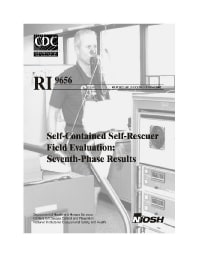Mining Publication: Self-Contained Self-Rescuer Field Evaluation: Seventh-Phase Results
Original creation date: March 2002
Authors: N Kyriazi, JP Shubilla
NIOSHTIC2 Number: 20021990
U.S. Department of Health and Human Services, Public Health Service, Centers for Disease Control and Prevention, National Institute for Occupational Safety and Health, DHHS (NIOSH) Publication No. 2001-127, Report of Investigations 9656, 2002 Mar :1-13
The National Institute for Occupational Safety and Health, National Personal Protective Technology Laboratory, has undertaken a study to determine how well self-contained self-rescuers (SCSRs), deployed in accordance with federal regulations (30 CFR 75.1714), hold up in the underground environment with regard to both physical damage and aging. This report presents findings regarding laboratory-tested SCSRs in the seventh phase of testing from May 1999 to August 2000. The SCRSs were tested on human subjects and on a breathing and metabolic simulator. The results indicate that most of the apparatus, if they pass their approved inspection criteria, perform satisfactorily. The developed CSE SR-100s, however, exhibited significantly higher inhaled carbon dioxide (CO2) levels than new units. as they did the in the previous two phases. Several Draeger OXY K-Pluses that rattled when shaken were found to have potassium superoxide (KO2) particles throughout the breathing circuit, including the mouthpiece. Draeger investigated the problem and developed a shake test to detect damaged units. The durations of new Ocenco M-20s were statistically significantly longer than those of deployed units, although only by 2 min.

NIOSHTIC2 Number: 20021990
U.S. Department of Health and Human Services, Public Health Service, Centers for Disease Control and Prevention, National Institute for Occupational Safety and Health, DHHS (NIOSH) Publication No. 2001-127, Report of Investigations 9656, 2002 Mar :1-13
- How to Operate a Refuge Chamber: A Quick Start Guide
- I Can't Get Enough Air! Proper Self-contained Self-rescuer Usage
- Performance Comparison of Rescue Breathing Apparatus
- Probability of Making a Successful Mine Escape While Wearing a Self-Contained Self-Rescuer
- Self-Contained Self-Rescuer Field Evaluation: Fifth-Phase Results
- Self-Contained Self-Rescuer Field Evaluation: First-Year Results of 5-Year Study
- Self-Contained Self-Rescuer Field Evaluation: Fourth-Phase Results
- Self-Contained Self-Rescuer Field Evaluation: Results From 1982-90
- Self-Contained Self-Rescuer Field Evaluation: Sixth-Phase Results
- Self-Contained Self-Rescuer Long Term Field Evaluation Tenth Phase Results